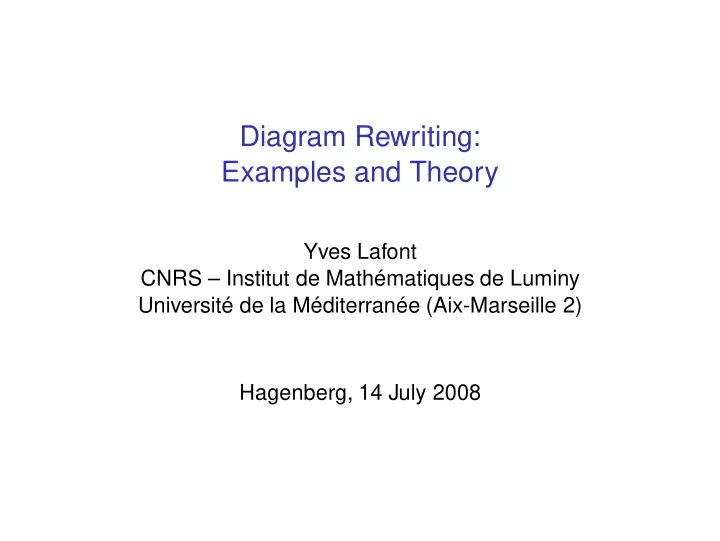

Diagram Rewriting: Examples and Theory Yves Lafont CNRS – Institut de Mathématiques de Luminy Université de la Méditerranée (Aix-Marseille 2) Hagenberg, 14 July 2008
Introduction ◮ Planar diagrams are 2-dimensional words. ◮ Terms can be encoded as diagrams (Burroni 91). ◮ Diagrams are related to proof nets / interaction nets. ◮ A word reduction can be seen as a planar diagram. ◮ Many other examples (braids, knots, circuits, . . . ).
Planar diagrams Inputs/outputs: φ Sequential and parallel composition: φ ψ φ ψ Laws of associativity, units, and interchange: φ ψ = = φ ψ ψ φ
Classification of interpretations Basic case (control flow): + (disjoint union) f : p → q ( p = { 1 , . . . , p } = 1 + · · · + 1 ) Classical case (data flow): × (Cartesian product) f : B p → B q ( B = { 0 , 1 } = 1 + 1 , B p = B × · · · × B ) Linear case: ⊕ (direct sum) f : Z p 2 → Z q ( Z 2 = { 0 , 1 } , Z p 2 = Z 2 ⊕ · · · ⊕ Z 2 ) 2 Quantum case: ⊗ (tensor product) f : B ⊗ p → B ⊗ q ( B = C 2 = C ⊕ C , B ⊗ p = B ⊗ · · · ⊗ B )
Example 1: S (finite permutations) Generator: Relations: = = Theorem: ◮ Any finite permutation is a product of transpositions: · · · · · · ◮ Two diagrams define the same permutation if and only if they are equivalent modulo the above relations.
Canonical forms Grammar for canonical forms: · · · · · · is void or · · · · · · · · · · · · · · · · · · is or · · · · · · Lemma: ◮ Any permutation corresponds to a unique canonical form. ◮ Any diagram reduces to a canonical form by these rules:
Proof of the lemma By double induction on the width (wires) and the size (gates). There are four cases: · · · · · · · · · · · · · · · · · · · · · · · · · · · · · · · · · · · · · · · · · · · · · · · · · · · · · · · · ·
Diagrams versus words Theorem: The symmetric group S n is presented by the generators σ i (for 1 ≤ i < n ) and the following relations: σ 2 i = 1 , σ i σ i + 1 σ i = σ i + 1 σ i σ i + 1 , σ i σ j = σ j σ i (for i + 1 < j ). Diagrammatic interpretation of relation σ 2 i = 1: = · · · · · · · · · · · · Diagrammatic interpretation of relation σ i σ j = σ j σ i : · · · · · · · · · = · · · · · · · · ·
Rewriting Theorem: This rewrite system is noetherian and confluent. ◮ Termination is straightforward. ◮ Confluence follows from the previous results. What are the critical peaks?
Confluence Confluence of critical peaks:
Global conflicts Here, there is one global conflict: · · · · · · φ · · · where φ is or · · · · · · · · · · · · It suffices indeed to consider the case where φ is canonical: · · · · · · φ ′ φ · · · · · · ∗ · · · · · · · · · φ ′ φ ψ · · · · · · · · · ∗ · · · · · · φ ′ φ · · · · · ·
Example 2: F (finite maps) Generators: Relations: = = = = = = =
Rewrite rules for F Termination is proved by using some polynomial interpretation.
The 68 critical peaks for F
Example 3: F op (theory of structural gates) Generators: Relations: = = = = = = =
Terms versus diagrams Theorem (Burroni 91): Any finite equational theory yields a finite presentation. Theorem (Lafont 95): Any finite convergent left linear term rewrite system yields a finite convergent diagram rewrite system. The non linear case is more difficult because of critical peaks.
Example 4: L ( Z 2 ) (linear boolean maps) Generators: x y x x x y y x x x x + y 0 Reversible gates: x y x y x y x y x x + y x + y y x + y x y x + y Decomposition: = = = =
Rewrite rules for L ( Z 2 )
Example 5: GL ( Z 2 ) (linear boolean permutations) Generators: Relations: = = = = = = Rules:
References ◮ Albert Burroni, Higher dimensional word problem (TCS 1993) ◮ Yves Lafont, Towards an algebraic theory of Boolean circuits (JPAA 2003) ◮ Yves Guiraud, Termination Orders for 3-Dimensional Rewriting (JPAA 2006) ◮ Yves Lafont & Pierre Rannou, Diagram rewriting for orthogonal matrices: a study of critical peaks (RTA 2008)
Recommend
More recommend